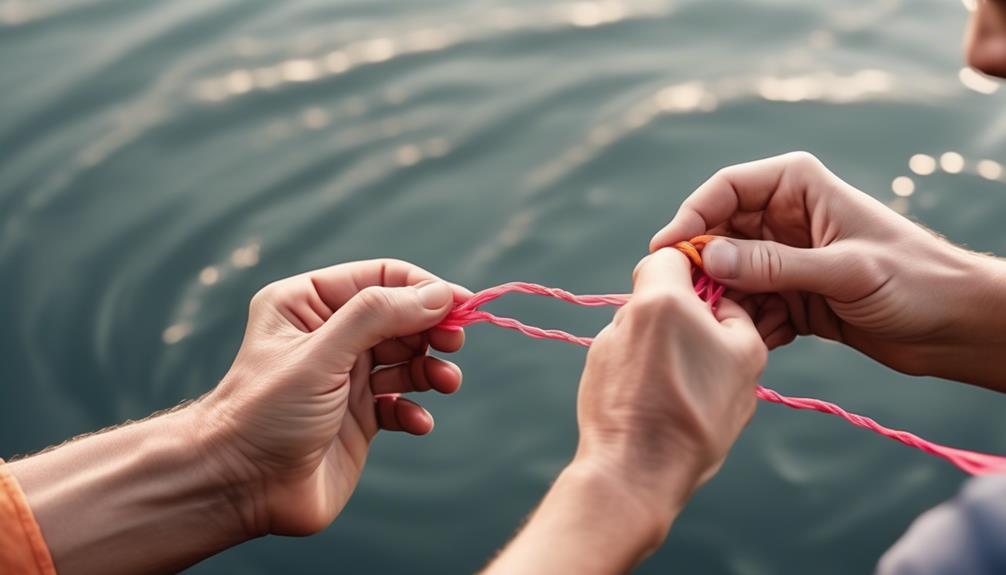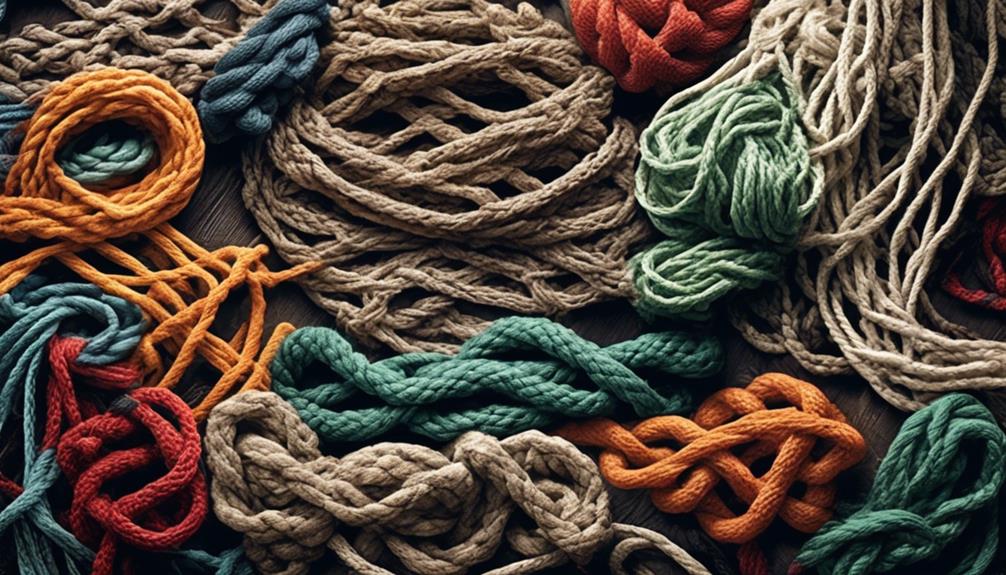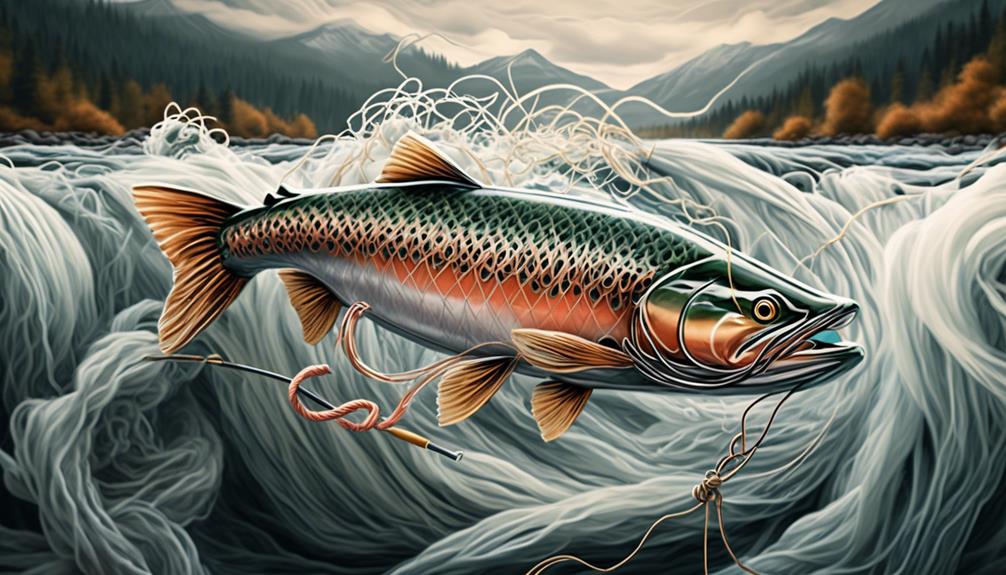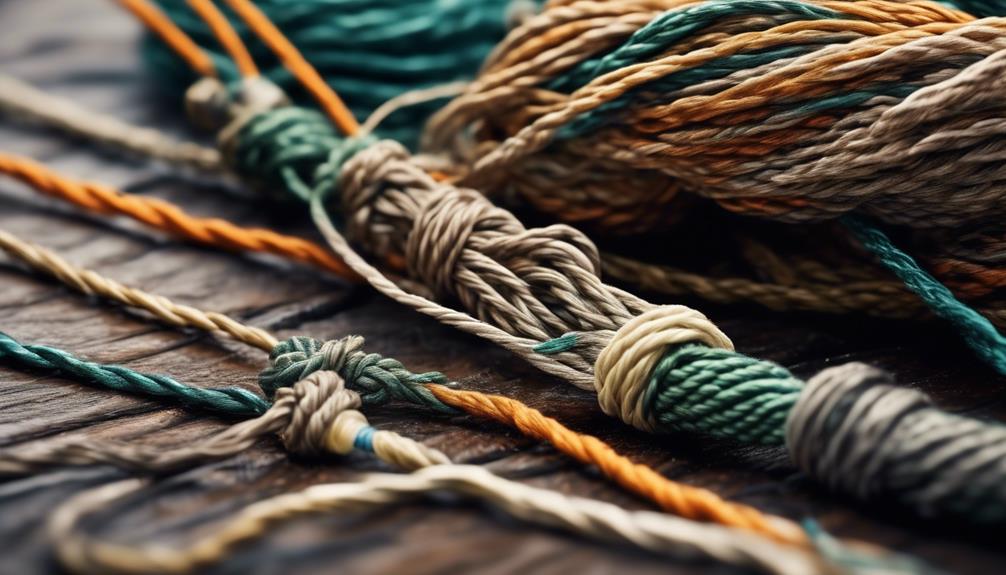Coincidentally, you've found yourself in the perfect place to learn about the easiest fishing knots to tie.
Whether you're a seasoned angler or just starting out, mastering a few simple knots can make a world of difference in your fishing success.
So, if you want to ensure your lines stay secure and your knots hold strong, stick around to discover the essential knots every angler should know.
Palomar Knot
To tie the Palomar Knot, begin by doubling the line and passing it through the eye of the hook. This knot is renowned for its strength and simplicity, making it a favorite among anglers.
One of the key advantages of the Palomar Knot is its exceptional strength, as it retains nearly the full breaking strength of the line. This reliability is crucial when targeting large, powerful fish species. Additionally, the Palomar Knot is easy to tie, even in low light conditions, which is a significant advantage for anglers in less-than-ideal fishing environments.
However, the Palomar Knot does have some disadvantages. For starters, it may not be the best choice for lines with a larger diameter. Thicker lines can be challenging to double over and thread through the hook eye, making the process more cumbersome. Furthermore, the Palomar Knot's strength can also work against it, as it may be too strong for some types of fishing. In situations where a line with slightly less strength is desired, the Palomar Knot may not be the optimal choice.
When comparing the Palomar Knot to the clinch knot, the Palomar Knot often comes out on top in terms of strength and reliability. While the clinch knot is easier to tie with larger lines, it typically can't match the Palomar Knot's strength and is more prone to slippage.
Ultimately, both knots have their strengths and weaknesses, but for many anglers, the Palomar Knot remains the knot of choice for its simplicity and resilience.
Clinch Knot
You can tie the clinch knot by threading the line through the eye of the hook and then wrapping it around the standing line. This knot is one of the easiest for beginners to learn and has several benefits that make it a popular choice for anglers.
Here are some tips for tying the clinch knot, especially in windy conditions:
- Benefits of clinch knot for beginners: The clinch knot is favored by beginners due to its simplicity and reliability. It's relatively easy to learn and has a strong hold, making it suitable for various fishing scenarios. As a beginner-friendly knot, it provides a great starting point for those new to fishing and knot tying.
- Ensure a secure grip: When tying the clinch knot in windy conditions, make sure to maintain a firm grip on the tag end and the standing line. This will prevent the wind from causing the lines to tangle and make it easier to complete the knot.
- Use the right technique: In windy conditions, it's important to use a steady and controlled technique when wrapping the line around the standing line. Keeping the movements precise will help you to create a tight and secure clinch knot.
- Double-check the wraps: Before tightening the knot, double-check that the wraps around the standing line are neat and snug. This is especially crucial in windy conditions, as any looseness can compromise the strength of the knot and its ability to hold against the pull of a fish.
Improved Clinch Knot
When tying the Improved Clinch Knot, it's important to ensure a snug and secure grip on the tag end and standing line, especially in windy conditions. This knot is advantageous because it's reliable and maintains a high percentage of the line's original strength.
To efficiently tie the Improved Clinch Knot, start by threading the line through the eye of the hook and doubling back parallel to the standing line. Then, make 5 to 7 wraps around the doubled line before threading the tag end through the loop near the eye of the hook. After moistening the knot, pull the tag end and standing line in opposite directions to tighten the knot securely against the eye of the hook.
The Improved Clinch Knot is favored for its ability to hold well against strong and feisty fish. Its advantage lies in its simplicity and effectiveness, making it an ideal choice for anglers of all skill levels.
To efficiently tie this knot, ensure that the wraps around the line are neat and tightly spaced. Additionally, moistening the knot before tightening helps to reduce friction and heat caused by the tightening process, which can weaken the line.
Uni Knot
The Improved Clinch Knot is a reliable choice, but if you're looking for a versatile knot that can be used in various fishing applications, the Uni Knot is an excellent option to consider.
The Uni Knot, also known as the Duncan Loop, offers several benefits that make it a favorite among anglers:
- Versatility: The Uni Knot is incredibly versatile and can be used for attaching hooks, swivels, and lures to the fishing line. Its adaptability to different types of fishing scenarios, whether freshwater or saltwater, makes it a go-to knot for many anglers.
- Strength: This knot retains a significant amount of the line's original strength, making it reliable for landing big catches. Its strength is particularly advantageous when targeting larger fish species.
- Easy to Tie: Unlike some other knots that can be complex and time-consuming to tie, the Uni Knot is relatively easy to learn and tie, even for beginners. With a bit of practice, you'll be able to tie this knot quickly and effectively.
- Uni Knot vs. Other Popular Fishing Knots: When compared to other popular fishing knots like the Improved Clinch Knot and Palomar Knot, the Uni Knot stands out for its versatility and ease of tying. It's particularly advantageous when a strong and reliable knot is needed for various fishing applications.
To tie the Uni Knot effectively, ensure that you moisten the knot before tightening and make a minimum of 4-6 wraps when tying. This will help maximize its strength and reliability.
Double Uni Knot
The Double Uni Knot, also known as the Grinner Knot, is an excellent option for connecting two lines of similar or different diameters in fishing applications. It's particularly useful when joining lines of different materials, such as braided line to monofilament or fluorocarbon. This knot is favored for its ease of tying and its ability to retain a significant portion of the line strength when tied correctly.
When tying the Double Uni Knot, it's important to consider the line strength of the materials being joined. This knot is versatile and can be used with various fishing line types, including monofilament, fluorocarbon, and braided lines. It's essential to ensure that the wraps are snug and well-executed to maintain the integrity of the knot. The Double Uni Knot is particularly effective when used with lines of similar diameters, but it also performs admirably when joining lines of differing thicknesses.
Understanding the characteristics of different fishing line types is crucial when choosing the appropriate knot for a specific application. The Double Uni Knot is a reliable choice for anglers who require a strong and secure connection between lines, especially when dealing with varying line diameters. With its simplicity and effectiveness, the Double Uni Knot is a valuable addition to any angler's repertoire.
Surgeon's Knot
To securely join two lines together, the Surgeon's Knot is a straightforward and reliable option for anglers of all skill levels. This knot is particularly useful when you need to connect two fishing lines of similar or different diameters. The Surgeon's Knot is known for its simplicity and strength, making it an essential knot to have in your fishing repertoire.
When it comes to tying technique, the Surgeon's Knot is incredibly easy to learn and master. Whether you're a beginner or an experienced angler, you can quickly and efficiently tie this knot without any hassle. Its uncomplicated process makes it an ideal choice for situations where you need to tie a strong and secure connection between two lines.
The Surgeon's Knot offers exceptional strength and reliability, ensuring that your lines remain firmly connected during intense battles with powerful fish. This knot's ability to maintain its integrity under pressure makes it a go-to option for anglers who prioritize durability and dependability in their fishing knots.
- Simple Tying Process: The straightforward steps involved in tying the Surgeon's Knot make it a favorite among anglers who value efficiency.
- Compatibility with Different Lines: This knot can be used to join lines of varying diameters, adding to its versatility.
- Strength and Durability: The Surgeon's Knot is renowned for its ability to withstand heavy loads and intense fishing conditions.
- Versatility in Fishing Scenarios: From freshwater to saltwater fishing, the Surgeon's Knot proves to be a reliable choice across various fishing environments.
Blood Knot
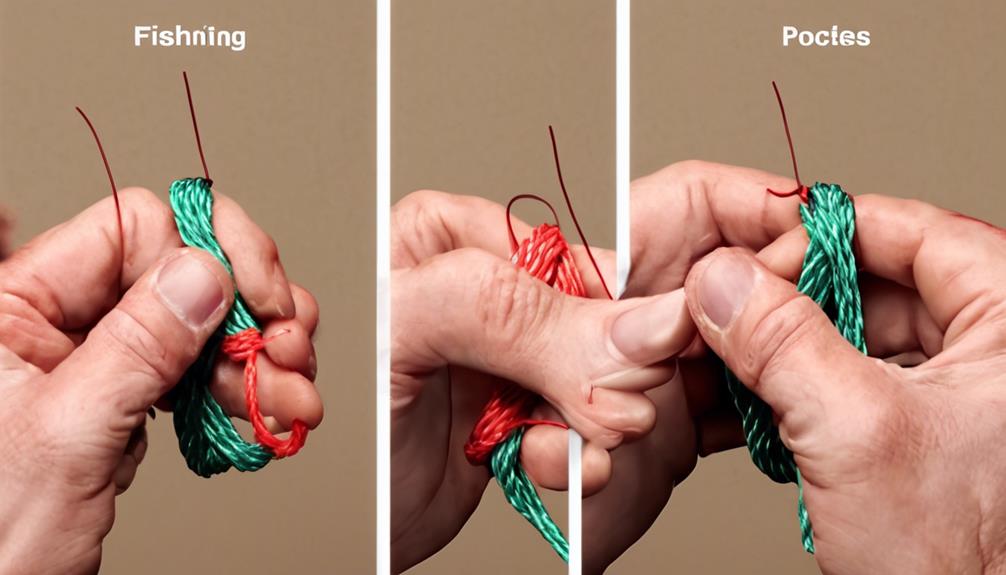
If you want to securely join two lines of similar or different diameters, the Blood Knot is a reliable and straightforward option for anglers of all skill levels. This knot is especially useful for fly fishing, creating a strong connection between the leader and tippet. Its applications extend beyond fly fishing, as it can be used for joining monofilament lines when setting up a spinning or baitcasting rig. The Blood Knot's main advantage lies in its ability to maintain a high portion of the lines' original strength when tied correctly. This makes it an ideal choice when a strong and streamlined connection is required.
When comparing the Blood Knot to other popular knots, it stands out for its simplicity and efficiency in joining two lines. Unlike the more complex knots, such as the Albright Knot, the Blood Knot can be tied quickly and easily, even in adverse weather conditions. Additionally, the Blood Knot maintains a slimmer profile compared to the Double Uni Knot, making it less likely to snag on guides when casting. Its straightforward tying process also sets it apart from the Nail Knot, which requires additional tools to complete.
Albright Knot
When tying the Albright Knot, focus on smoothly wrapping the heavier line around the lighter line to create a secure and streamlined connection. This knot is particularly useful for joining different types of fishing lines, such as connecting a monofilament leader to a braided mainline.
Here are some key points to keep in mind when using the Albright Knot:
- Albright knot strength: The Albright Knot is known for its exceptional strength. When tied correctly, it can maintain a high percentage of the line's original breaking strength, giving you confidence when battling larger fish.
- Albright knot uses: This knot is versatile and can be used in various fishing scenarios. Whether you're targeting freshwater species like bass and trout or tackling saltwater game fish such as tarpon or snook, the Albright Knot proves to be reliable.
- Practice makes perfect: While the Albright Knot offers great strength, it may take some practice to master. Focus on keeping the wraps neat and tight to ensure the knot's effectiveness.
- Trim excess line: Once the Albright Knot is tied, it's essential to trim any excess line closely to the knot. This helps prevent any interference when casting or reeling in a catch.
Frequently Asked Questions
What Are the Best Types of Fish to Catch Using Each of These Knots?
To find the best baits for each knot, consider the type of fish you're targeting.
For example, a Palomar knot is great for bass fishing, so try using plastic worms or crankbaits.
For ideal fishing locations, the improved clinch knot works well for trout in streams, while the uni knot is versatile and can be used for various types of fish in different locations.
Are There Any Specific Types of Fishing Line That Work Better With These Knots?
When it comes to fishing line compatibility, it's important to match the knot strength with the type of fishing line you're using. Certain knots work better with specific types of fishing line, so it's essential to consider this when tying your knots.
Additionally, knot-tying tools and alternative materials can also affect the ease and effectiveness of tying fishing knots. These factors can make the process simpler and more efficient for you.
Can These Knots Be Used for Saltwater Fishing as Well as Freshwater Fishing?
When fishing in saltwater or freshwater, it's important to consider knot strength. Knots like the improved clinch and Palomar work well in both environments.
However, for saltwater fishing, you may need to adapt your tying techniques to accommodate stronger ocean currents. It's crucial to test the knots' strength and adjust if needed.
With the right adjustments, these knots can be reliable for both saltwater and freshwater fishing.
Are There Any Special Techniques or Tips for Tying These Knots in Windy or Rough Conditions?
When tying knots in windy conditions, it's essential to stay focused and keep the line taut. Use your body to shield the knot and keep your hands steady.
For rough conditions, try wetting the line before tying to reduce friction. If possible, find a sheltered area to tie the knot.
Additionally, practice tying the knots in different conditions to build confidence and skill.
These tips will help you secure your knots effectively in challenging situations.
What Are the Most Common Mistakes People Make When Tying These Knots, and How Can They Be Avoided?
When tying fishing knots, common mistakes can lead to frustration. To avoid issues, focus on prevention techniques.
Improve your knot tying skills by practicing with different types of lines and using proper knot tying tools. Consider learning alternative knot tying methods to find what works best for you.
Conclusion
So, whether you're a beginner or an experienced angler, these easy fishing knots will come in handy for all your fishing adventures.
With a little practice, you'll be able to tie these knots quickly and efficiently, ensuring a secure and reliable hold on your fishing line.
Happy fishing!
